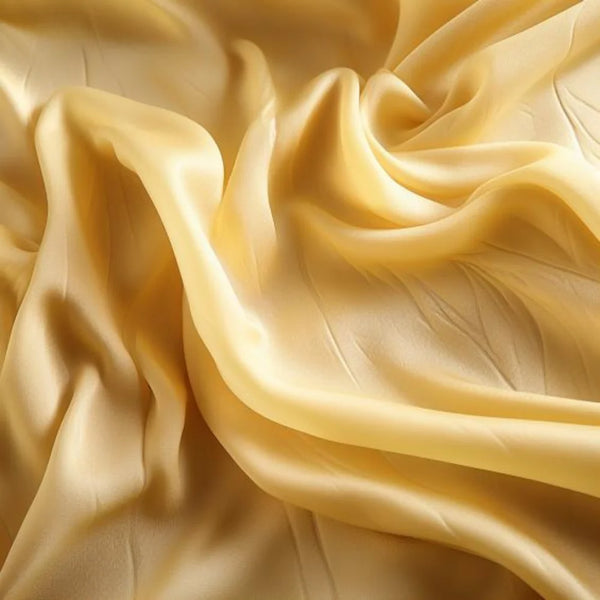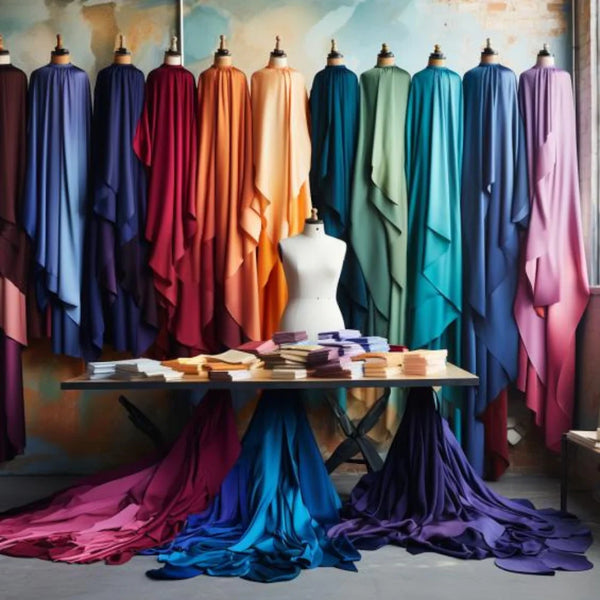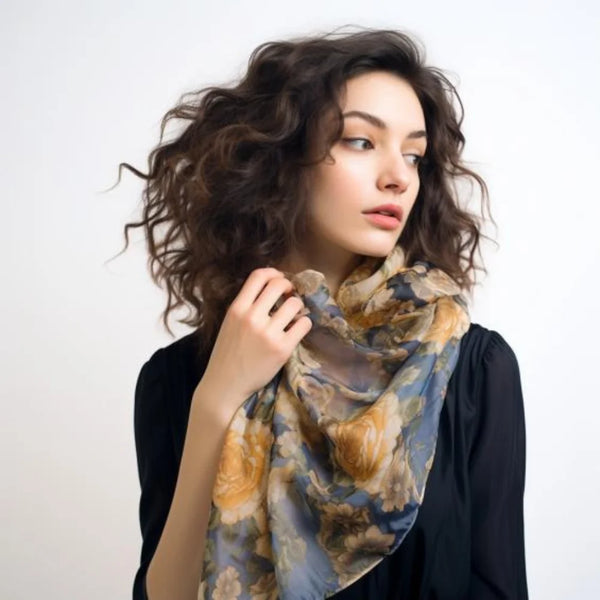Key Takeaways
silk crepe is a fluid, soft and shiny fabric appreciated for its unique texture. Coming from a long Asian artisanal tradition, it is today used all over the world to make elegant clothing, notably making dresses.
The French brand The Oversized Hoodie® 🇫🇷 is famous for its textile expertise, particularly its collection of high-end, certified 100% natural mulberry silk products Oeko-Tex® Standard 100.
Free from toxic and chemical substances, and ecological, the collections silk pillowcase, night mask and silk sheets stand out for their incomparable softness and excellent value for money, providing an unrivaled feeling of comfort.
The origins of silk crepe fabric
The silk crepe takes its name from its particular texture, creped and crumpled. This fabric has its origins in China, where sericulture (silkworm breeding) and silk weaving have existed for millennia.
The ancestral technique of hand-weaving silk crepe was reserved for an elite. The artisans created unique pieces, with complex patterns, for the Chinese imperial court. The process was jealously kept secret.
Hand weaving of silk crepe is an ancestral know-how that requires patience and dexterity. As the founder of The Oversized Hoodie, I was able to see to what extent the artisanal production of this noble fabric requires attention to detail and passion.
— Geoffrey, Founder of The Oversized Hoodie®
It was only in the 19th century that the industrial manufacture of silk crepe became democratized in Asia, allowing its export to Europe and America. Today, China, Japan and India dominate the global market.

Also read: What are the different types of silk ?
The Unique Characteristics of Silk Crepe
silk crepe is distinguished from other fabrics by its very characteristic wrinkled texture. Unlike satin or chiffon which are smooth, crepe has a pleated and grainy appearance.
This creped effect is obtained thanks to a particular twist of the threads during weaving, which gives them a wavy and nervous appearance. Crepe can be more or less pronounced depending on the type of silk used.
Another signature of silk crepe: its silky, soft and supple hand. This pleasant sensation to the touch is provided by the silk fibers which make up the fabric. Silk also gives crepe its characteristic shine.

The different types of silk crepe: heavy, satin, chine
There are several varieties of silk crepe, which are distinguished by:
- Their thickness: crepe fine or heavy
- Their degree of shininess: crepe satin or matte
- Their degree of creased: crepe chine or curled
The most common is crêpe de Chine, with a fluid and vaporous texture.
The satin crepe has more shine thanks to its satin weave.
The Georgette crepe is very fine and airy.
As for the heavy crepe, its drape is more consistent.

Also read: What is mulberry silk ?
Use of silk crepe in making
Thanks to its unique qualities of fluidity, lightness and shine, silk crepe is a fabric of choice for making women's clothing.
It is used in particular to make dresses, blouses, skirts, trousers or even accessories (scarves, scarves). The crepe perfectly matches the shape of the body for a very elegant look.
Its texture allows you to design both casual outfits (shirt dress) and more dressy silhouettes (evening dress).
Silk crepe enhances prints. The floral and plant patterns like the stripes provide pretty visual effects.

Also read: What is Tussah silk ?
Creation of clothes with silk crepe: dress, blouse, pants, skirt
Among the iconic models made in this noble fabric, the little black dress immortalized by Coco Chanel or the wrap dress by Yves Saint Laurent.
Silk crepe lends itself to multiple fashion transformations:
- Shirt dress: fluid, vaporous, relaxed
- Wrap dress: fitted and structured
- Skirt: straight, flared or pencil
- Trousers: cigarette, palazzo, spindle
- Blouse: oversize, cropped, loose
- Blouse: romantic, bohemian
Whether plain, patterned, dark or pastel, matte, satin or shiny, crepe enhances all silhouettes.

Also read: The Synthetic Silk Revolution: Between Innovation and Sustainability
Care and washing of silk crepe
Fragile, silk crepe requires certain care during its maintenance:
- Hand wash in cold water
- Use a silk shampoo
- Dry flat
- Ironing with a warm iron on the reverse side
Be careful of limescale and chemicals which can damage the delicate fibers of silk.
Well maintained, a silk crepe garment can last for years without losing its shine!
At The Oversized Hoodie®, we strongly recommend regular maintenance of silk crepe clothing to preserve their quality over time. A good silk shampoo used when washing by hand will allow the fabric to maintain softness and shine.
— Geoffrey, Founder of The Oversized Hoodie®
Also read: Everything you need to know about silk satin
Price per meter of silk crepe: white, sky blue, ivory, printed
Count on average between €15 and €30 per meter for quality silk crepe.
Price varies depending on:
- The finesse: the finer the crepe, the higher the price
- The colors: count €10 more for bright shades
- patterns: prints and embroidery drive up prices
On specialized e-shops, here are some examples of prices:
- Plain ivory silk crepe: €22 per m
- Floral printed silk crepe: €25 per m
- Sky blue dyed silk crepe: €35 per m

Also read: Silk Chiffon: Luxury and Lightness
Alternatives to silk crepe: wool and other fabrics
Less expensive than silk, other fabrics are suitable for elegant outfits:
- The fine wool: sheet, wool crepe
- cotton: poplin, cotton voile, cambric
- blends: silk and cotton, silk and wool
These alternatives offer a pleasant fit and feel at more accessible prices.
For a flowing dress or an airy blouse, cotton crepe and wool crepe are excellent choices.
Conclusion
With its airy drape and soft hand, silk crepe brings fluidity and elegance to feminine silhouettes. Dresses, skirts, blouses take on a new dimension in this refined fabric with sumptuous shine.
Textile heritage of the Silk Route, silk crepe seduces with its history as much as its natural beauty, with its timeless charm.
| Silk Crepe Type | Features | Usage | Maintenance |
|---|---|---|---|
| Crêpe de Chine | Fluid and vaporous texture, slight shine | Dresses, blouses, accessories | Hand wash, dry flat, iron warm |
| Satin Crepe | Enhanced shine, smooth texture | Elegant women's clothing | Hand wash, dry flat, iron warm |
| Georgette crepe | Very fine and airy, slightly transparent | Skirts, light dresses, scarves | Hand wash, dry flat, iron warm |
| Heavy crepe | Consistent fall, less shine | Evening wear, structured clothing | Hand wash, dry flat, iron warm |
FAQ
What is silk crepe ?
silk crepe is a silk fabric with a fluid and vaporous drape. Its texture has a very characteristic pleated appearance which gives it a crinkled appearance.
What are the different types of silk crepe ?
There are many types of silk: crepe de Chine, Georgette crepe, charmeuse, duchess, organza, shantung, scarf, satin, taffeta... They are distinguished by their texture, their weight, their shine and their flexibility.
How to recognize fabric crepe ?
A crepe fabric can be recognized by its grainy texture and its wrinkled appearance.Unlike a smooth fabric like satin or voile, crepe has folds and cracks that form a grainy pattern.
How to wash silk crepe ?
The silk crepe must be washed by hand, in cold water, with a silk shampoo. It cannot be machine washed or tumble dried and must be dried flat.
Updated February 9, 2024







